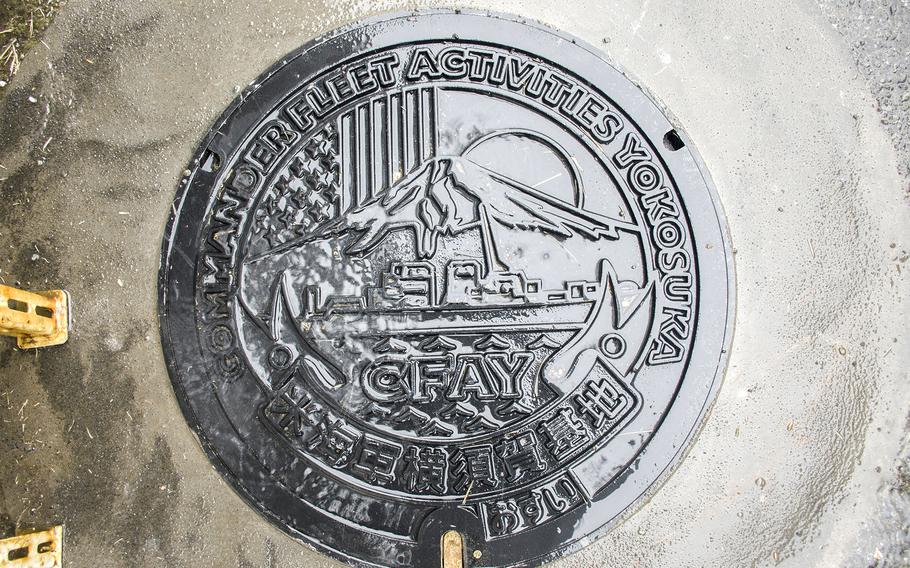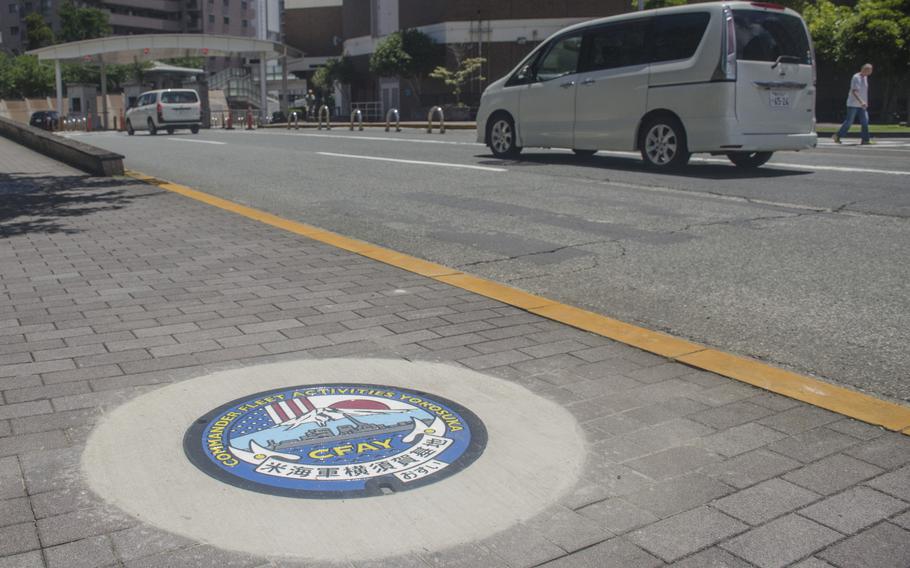
One of three distinctive manhole covers on Yokosuka Naval Base, Japan, on June 18, 2024. (Jennessa Davey/Stars and Stripes)
A piece of Japanese pop culture has found its way onto Yokosuka Naval Base, home of the U.S. 7th Fleet.
To find it, just look down.
“I was surprised to see all the positivity from people who are on- and off-base and how interested everyone was about this project,” Satomi Furuno, a production control specialist at Naval Facilities Engineering Systems Command told Stars and Stripes during a Teams call Thursday. “I was so happy to do a job that makes people smile.”
Furuno designed the three manhole covers installed on the Navy base in May and June, with more coming soon. They are the first of 25 covers planned to replace worn covers over access holes into the subterranean sewage system.
The command would not disclose the cost to produce the manhole covers, according to an email Monday from naval base spokesman Justin Keller to Stars and Stripes.

A brand new, colorful manhole cover, seen here June 24, 2034, was put in place near the main gate at Yokosuka Naval Base, Japan, on June 23, 2024. (Jennessa Davey/Stars and Stripes)
Designer manhole covers appeared on streets in Japan in the 1970s, according to Web Japan, a website maintained by the Japan Ministry of Foreign Affairs.
The first covers were installed in Naha, the capital of Okinawa, in 1977, according to the website. The design is a happy fish in water that had been cleaned by the sewer system.
Japan started producing manholes in 1981 that are coated with colorful fluorescent paints. They have a practical role in firefighting activities and serve as guides at night.
Today, manhole covers are a “region-specific” art form that attract their own aficionados, according to Web Japan. Some covers depict popular Japanese icons like Hello Kitty, Astro Boy and Pokemon.
As evidence of their popularity, a Facebook group, Japan Manhole Cover Club, boasts 7,300 members.
At Yokosuka, the manhole cover, a heavy metal disk usually overlooked by traffic and passersby, bears the naval base command crest with the Japanese hiragana character for “osui,” or sewage, near the cover’s edge. The base Public Works Department production team came up with the design, Furuno said.
The hardest part of the project was getting the design just right, she said.
“I struggled a little bit with redesigning it because it is a very popular design, everyone knows what our logo looks like, so I tried to stay as close as the original design as possible,” she said. “But it was fun to design and turned out beautiful.”
The first manhole cover on the naval base was installed in May near the wastewater treatment plant on the edge of Mitscher Street. The monochromatic cover is on a narrow side street accessible only via E Street. The site is isolated and may be hard to find.
The second cover, installed June 12, is a colorful version near the Navy-Marine Corps Relief Society and the Yokosuka Thrift Shop, Furuno said. This manhole will be easy for guests to see during events like Yokosuka Spring Festival and Yokosuka Friendship Day.
The third cover was installed Saturday just inside the naval base’s main gate on King Street.
The remaining manholes will be installed as the older and damaged ones are identified, Furuno said.
The naval base Public Works Department “is proud to bring this Japanese cultural tradition to our base for the enjoyment and enrichment of our 26,000 tenants and visitors,” public works officer Cmdr. Tyler Scharar said in a news release May 24. “This effort was led by our [public works] Japanese teammates who are totally committed to the success of the U.S. Navy and the many Sailors and families who get to call Yokosuka their home.”